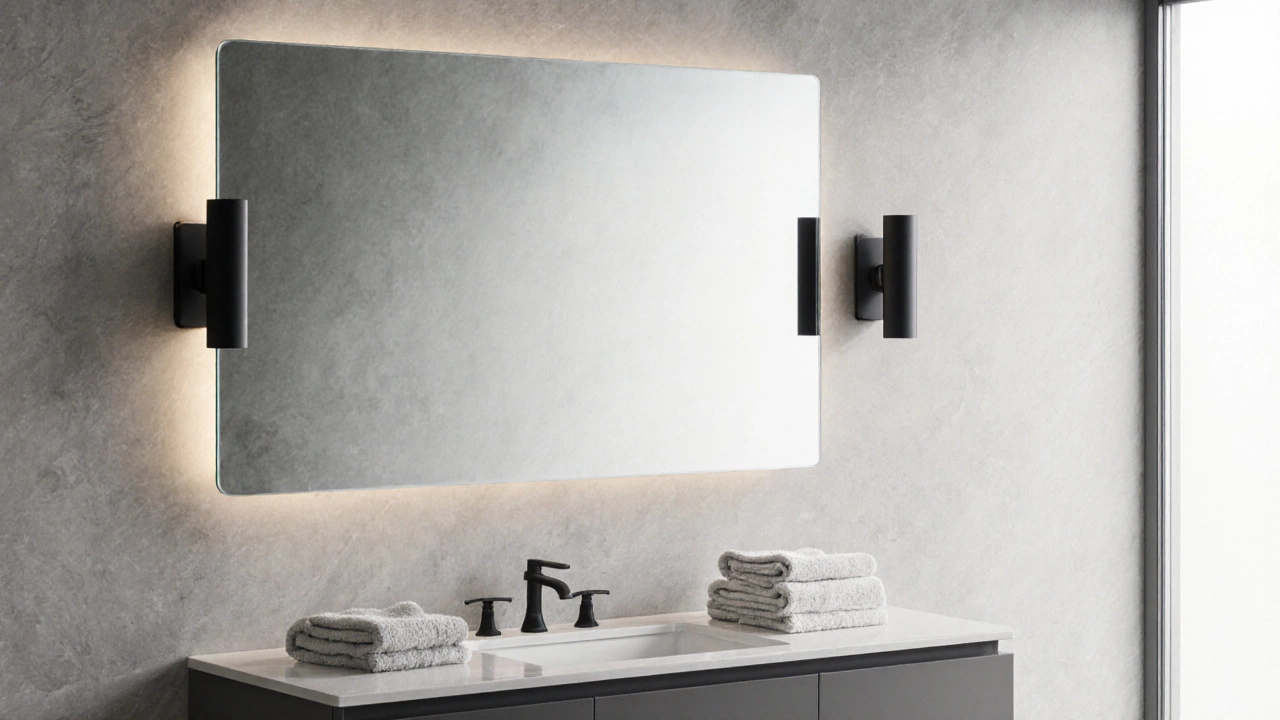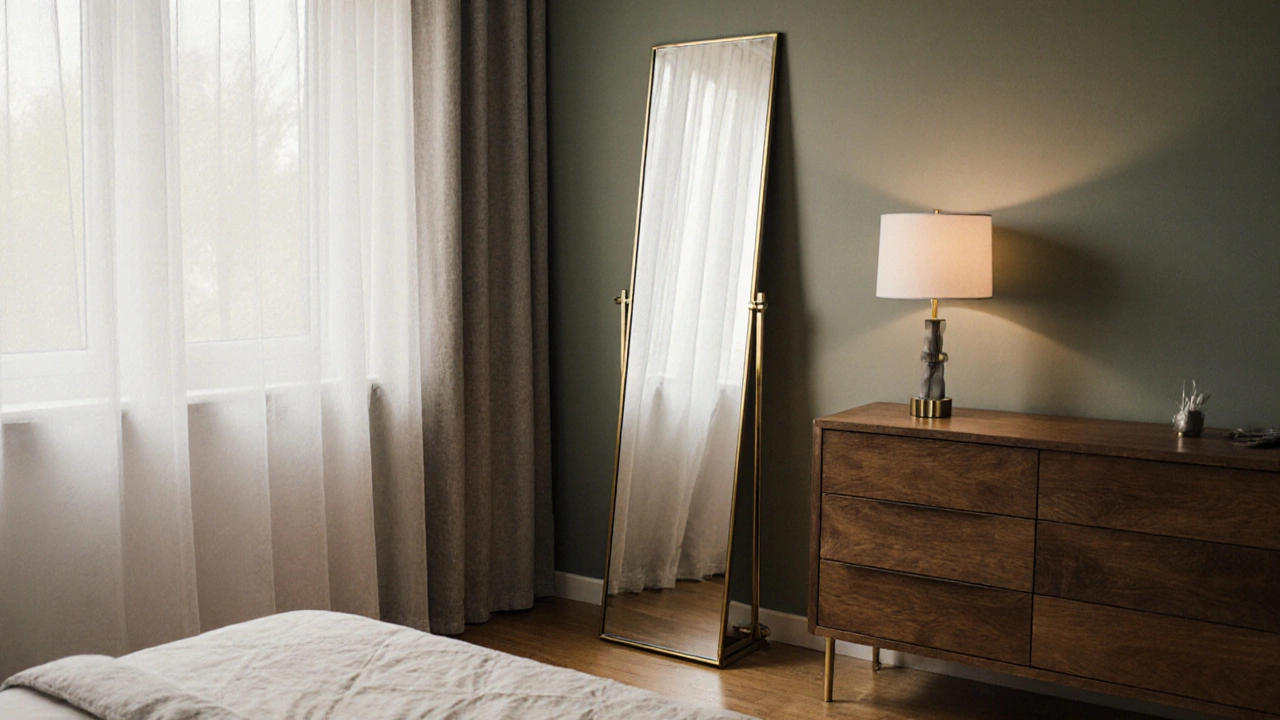What Should Your Mirrors Look Like? A Practical Guide to Style, Size, and Placement
 Nov, 9 2025
Nov, 9 2025
Mirror Size Calculator
Determine Your Perfect Mirror Size
Based on the article's guidelines for mirror sizing, placement, and room compatibility.
Ever walk into a room and feel something’s off-even though everything looks fine? More often than not, it’s the mirror. A bad mirror can make a space feel cramped, dated, or just plain awkward. A good one? It opens up a room, reflects light, and adds character without saying a word. So what should your mirrors look like? It’s not about picking the shiniest or biggest one. It’s about matching the mirror to your space, your light, and your life.
Size matters more than you think
A mirror that’s too small feels like an afterthought. One that’s too big overwhelms the wall and can make a small room feel like a funhouse. The rule of thumb? Your mirror should be two-thirds the width of the furniture beneath it. That’s why a 60-inch vanity usually pairs with a 40-inch mirror-not because it’s trendy, but because it looks balanced.
In a narrow hallway or above a console table, go for a tall, narrow mirror. It adds height without eating up wall space. In a living room, a large floor mirror leans against the wall like a piece of art. In a bathroom, don’t just center it over the sink-extend it to the edges of the vanity. That small shift makes the whole space feel wider.
And don’t forget proportion with ceiling height. In rooms with 9-foot ceilings, a mirror that’s 30 inches tall can look lost. Try 40 to 48 inches. In older homes with 8-foot ceilings, keep it under 40 inches to avoid crowding the space visually.
Frame or no frame? It’s a mood choice
A framed mirror adds structure. A frameless one feels modern and light. Neither is better-it’s about the feeling you want.
Wood frames bring warmth. A reclaimed oak frame in a farmhouse kitchen or bedroom ties into the flooring or cabinetry. Thin metal frames-brushed brass, matte black, or aged bronze-add a touch of luxury without heaviness. They work well in bathrooms or above a minimalist dresser.
Frameless mirrors? They’re the ultimate clean-slate option. They’re great for bathrooms where you want the focus on the surface, not the border. But they need a solid backing. If your wall is uneven or painted a dark color, a frameless mirror can look like a hole. A thin border, even just 1/4 inch of beveled edge, helps it feel intentional.
And avoid cheap plastic frames. They yellow over time, especially in humid bathrooms. Stick to real wood, solid metal, or high-quality resin. You’ll notice the difference after six months.
Shape isn’t just decorative-it changes flow
Round mirrors soften a room. Think of them as visual punctuation. In a sharp, angular living room with square sofas and straight lines, a round mirror breaks the monotony. It’s why you see them often in Scandinavian and Japandi interiors.
Rectangular mirrors are the workhorses. They’re predictable, easy to hang, and match most furniture. They’re your safe bet for entryways, bedrooms, and bathrooms.
Oval mirrors? They’re the middle ground. Less bold than round, less rigid than rectangle. They work well above a bed or in a powder room where you want elegance without fuss.
Don’t overthink shapes in small spaces. A large round mirror in a tiny bathroom can make it feel like a cave. Stick to vertical rectangles or narrow ovals. In large rooms, go wild. A sunburst mirror in a dining room? Yes. A giant hexagon in a home office? Why not.

Lighting is the silent partner
A mirror doesn’t work alone. It needs light to do its job. A mirror in a dark corner? It’s just a piece of glass. A mirror across from a window? That’s magic.
If you’re hanging a mirror in a bathroom without natural light, pair it with vertical sconces on either side. Avoid overhead lights-they cast shadows under your eyes and make you look tired. Side lighting creates even illumination. That’s why professional makeup artists use them.
In a hallway or living room, position your mirror to reflect a lamp or a window. You’re not just reflecting a surface-you’re doubling the light. One study from the University of Auckland’s design lab found that mirrors placed to reflect natural light can reduce the need for artificial lighting by up to 22% during daylight hours.
And never put a mirror directly across from a TV. It creates glare and turns your evening show into a distracting light show.
Where to hang it-and where not to
Eye level is the golden rule. The center of the mirror should be about 57 to 60 inches from the floor. That’s average eye height for most adults. If you’re hanging it above a piece of furniture, leave 6 to 8 inches of space between the top of the furniture and the bottom of the mirror.
Don’t hang mirrors across from doors. It creates a disorienting effect-like you’re walking into another room. In bedrooms, avoid placing mirrors directly across from the bed. It’s not superstition. It’s psychology. People report feeling more at ease when they can’t see their reflection when lying down.
Entryways are prime real estate for mirrors. A full-length mirror near the door helps with last-minute checks. A smaller one near the coat rack lets you see your whole outfit before walking out. In Auckland’s weather, where rain and wind can mess up hair and layers, this isn’t luxury-it’s practical.

Special cases: bathrooms, bedrooms, and small spaces
Bathrooms: Moisture is the enemy. Avoid wooden frames unless they’re sealed with a moisture-resistant finish. Glass mirrors with aluminum backing are best. Look for anti-fog coatings if you live in a humid climate. You’ll thank yourself after your first steamy shower.
Bedrooms: Full-length mirrors are essential. But don’t just lean one against the wall. Mount it on a pivot or use a freestanding frame with a weighted base. It’s safer and looks more intentional. If you have a walk-in closet, install a mirror on the inside of the door. It saves space and gives you a full-body view without cluttering the floor.
Small spaces: Mirrors are your best friend. A mirror on one wall can make a 10x10 room feel like 12x12. But don’t use multiple small mirrors. They look like a collage. One large mirror, centered and clean, does the job better. In apartments with limited windows, place a mirror opposite the light source. It tricks the eye into thinking the room is brighter and bigger.
What to avoid
Don’t buy mirrors based on trends alone. A gold-trimmed oval mirror might look stunning in a magazine, but if it clashes with your lighting and furniture, it’s just expensive clutter.
Avoid mirrors with thick, ornate borders in modern homes. They date quickly. And never install a mirror without checking the wall behind it. Drywall can’t hold a heavy mirror without proper anchors. Use wall studs or toggle bolts. A falling mirror isn’t just a mess-it’s dangerous.
And skip the novelty mirrors. Heart-shaped, animal-shaped, or glitter-covered ones might be fun for a teenager’s room, but they rarely age well. Stick to clean lines and timeless materials.
Final checklist: Does your mirror pass the test?
- Is it sized right for the wall or furniture beneath it?
- Does the frame match the room’s style-not fight it?
- Is the shape helping the room feel balanced?
- Does it reflect natural or good artificial light?
- Is it hung at eye level, not too high or too low?
- Does it avoid awkward placements (opposite doors, beds, TVs)?
- Is it built to last in its environment (e.g., moisture-resistant in bathrooms)?
If you answered yes to all seven, you’ve got a mirror that doesn’t just reflect your face-it reflects good design.
Should I put a mirror in my bathroom?
Yes-but make sure it’s designed for moisture. Choose a mirror with an anti-fog coating and a frame made of sealed wood, metal, or high-quality resin. Avoid untreated wood or cheap plastic, which warp or discolor over time. Position it so it reflects good lighting, ideally from side-mounted sconces, not overhead fixtures.
How high should I hang a mirror?
The center of the mirror should be between 57 and 60 inches from the floor. That’s average eye level. If hanging above furniture, leave 6 to 8 inches between the top of the furniture and the bottom of the mirror. This creates visual breathing room and prevents the mirror from feeling stuck.
Can a mirror make a small room look bigger?
Absolutely. One large, well-placed mirror can trick the eye into thinking a room is larger. Place it opposite a window or light source to reflect natural light. Avoid multiple small mirrors-they look cluttered. Stick to one clean, full-sized mirror for maximum impact.
What’s the best mirror shape for a bedroom?
A full-length rectangular or oval mirror works best. It lets you see your whole outfit and fits naturally next to a dresser or wardrobe. Avoid round mirrors unless they’re small accent pieces-full-length round mirrors are hard to position and rarely useful for getting dressed.
Are frameless mirrors a good choice for bathrooms?
Yes, if the wall behind is smooth and light-colored. Frameless mirrors give a clean, modern look and are easier to clean. But they need solid backing-drywall alone isn’t enough. Use toggle bolts or mount into studs. A slight beveled edge helps it feel intentional, not like a hole in the wall.
Can mirrors improve lighting in a dark room?
Yes, if placed correctly. Position a mirror to reflect a window or a lamp. It doesn’t add more light, but it redirects what’s already there. A mirror across from a window can double the daylight in the room. This is especially helpful in Auckland’s overcast winters.
What materials should I avoid in bathroom mirrors?
Avoid untreated wood, cheap plastic, and unsealed MDF. These materials swell, warp, or peel in humid environments. Stick to sealed wood, aluminum, stainless steel, or high-grade resin. The mirror glass itself should have an aluminum backing, not silver, for better moisture resistance.